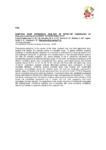Please use this identifier to cite or link to this item:
http://www.alice.cnptia.embrapa.br/alice/handle/doc/1003884| Title: | Temporal gene expression analysis of effector candidates of Phakopsora pachyrhizi across the infection cycle. |
| Authors: | POLIZEL-PODANOSQUI, A. M.  CARVALHO, M. C. C. G. de   ROCHA, C. S.   DARBEN, L. M.   LOPES-CAITAR, V. S.   AOYAOGI, L. N.   MARCELINO-GUIMARÃES, F. C.   |
| Affiliation: | CNPSO UENP CNPSO UENP CNPSO CNPSO FRANCISMAR CORREA MARCELINO-GUIMARÃES, CNPSO. |
| Date Issued: | 2014 |
| Citation: | In: INTERNATIONAL CONGRESS ON MOLECULAR PLANT-MICROBE INTERACTIONS, 16., 2014, Rhodes. [Abstracts...]. Atenas: International Society of Molecular Plant-Microbe Interactions, 2014. |
| Description: | Phakopsora pachyrhizi is the causer of the Asian soybean rust, the most aggressive foliar disease that attacks the soybean plants in cultivated areas. To design effective breeding strategies for durable disease resistance it is important to understand the molecular basis of this plant-pathogen interaction. In particular, the characterization of the secreted effector proteins can help the breeding programs. Our recent analysis of the P. pachyrhizi secretome has revealed the presence of potential effectors genes. In this work, the temporal expression of 58 effector candidate genes were characterized from spores, germinated spores and infected soybean leaves at 0, 6, 12, 24, 36, 48, 72, 96, 192 and 240 hours after inoculation (hai) using RT-qPCR. Expression analysis showed differential temporal gene expression of these candidate effectors. Clustering analysis revealed three main clusters with coordinated expression of candidates across the infection cycle. The first has candidates expressed in specific steps of infection and almost sequences have the common motifs Y/F/WxC frequently found in haustoria-producing rust fungi effectors. The second cluster has candidates expressed during initial steps of infection that matches germ tube and appressorium formation (0 – 24 hai) and almost sequences have ?3 cysteine residues, other common features of the effectors. Third cluster has candidates expressed only in contact with the host, suggesting that these candidates are host-induced. The sequences in this cluster have the CFEM domain associated with pathogenicity. Functional analyses are in progress with more promising candidates effectors to validate the potential effectors from soybean rust. |
| Keywords: | Ferrugem asiática da soja |
| Type of Material: | Resumo em anais e proceedings |
| Access: | openAccess |
| Appears in Collections: | Resumo em anais de congresso (CNPSO)  |
Files in This Item:
| File | Description | Size | Format | |
|---|---|---|---|---|
| TemporalgeneexpressionanalysisofeffectorcandidatesofPhakopsorapachyrhiziacrosstheinfectioncycle.pdf | 69.85 kB | Adobe PDF |  View/Open |









